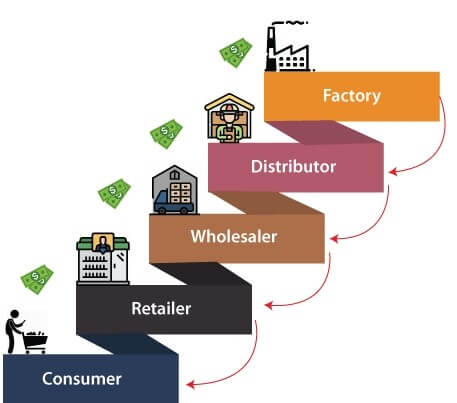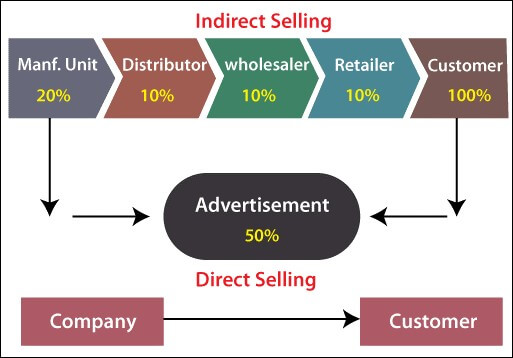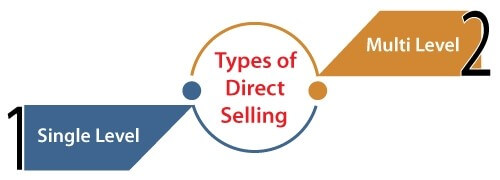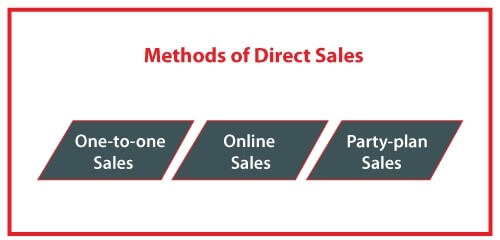What is Direct Selling
As the name suggests, direct selling is the new business model that is free from the middlemen or intermediaries like distributor, the wholesaler, and the fixed retail stores who are generally involved in the traditional business models. It is done either online, at home, or a venue other than a store. Using this business model, the company sells the product directly to the customer with the help of an independent salesperson or sales representative.
Direct Selling Over Indirect Selling
Before moving to the comparison, let us understand what Indirect selling is:
Indirect selling is the traditional approach of business that allows the third party like the distributor, the wholesaler, and the retailer to make entry so that the company can sell its product to the consumer. In this model, the product price depends on manufacturing cost and the number of mediators taking part in the whole journey of the product, i.e., from the manufacturing unit to the consumer. And this factor of price determination makes the product available at a high price for the consumer.

Indirect Selling
Let's Understand With the Following Figure

Here in traditional business, the product is being reached to the customer passing through different phases. A total marked price that customers pay to buy the product contains the marginal profit made at each level. The 50 percent of the price which consumer pay is used to spent on the product advertisement. That is why we can observe the massive gap between the manufacturing cost and market price.
In the 2nd half of the figure, it is visible that in direct selling, only two-party that is, company and consumer are there and eliminates others, leading to profitable and affordable business.
Now Coming To The Comparison Based On Few Parameters:
- Cost: The price offered by direct selling is comparatively lower than that offered in indirect selling.
- Manufacturer-Consumer Interaction: In direct selling, interaction is easily possible as the consumer approaches the product directly through the independent salesperson or sales representative of the company. While in Indirect selling, the interaction is done through intermediaries, like retailers, wholesalers, and the distributor, which is time-consuming and less effective.
- Globally Acceptance: All online businesses are an example of direct selling and have a wider audience range from all over the globe, so it is globally accepted. In contrast, indirect selling still has a limited scope.
- Company-Customer Relationship: In direct selling, the relationship between company and consumer is kept at priority. The relationship is established as the company provides an offer as well as a source of income (in MLM). In contrast, indirect selling doesn't facilitate better company-customer relationships due to the availability of many in between partners.
- Valuable Feedback: To maintain effectiveness, feedback is very important and is fully functional in direct selling but absent in indirect selling.
Types of Direct Selling
There are mainly two types of direct selling business.
- Delegation Direct Selling or Single-Level Direct Selling
- Multi-Level Marketing (MLM)

Let's Discuss About Each In Detail
1. Delegation Direct Selling or Single-Level Direct Selling
In single-level direct selling, the company sells their product through a sales representative, or we can say through delegates, and in return, they are awarded the commission and incentives. In this selling, the salesperson is accountable for trading the products, and no team is formed in this marketing. For example, most of the Real-estate Business runs over the single-level model as they use delegates as a marketer to sell the product.
2. Multi-Level Direct Selling
Multi-level direct selling is the most trending selling nowadays. In this selling, the consumer also acts as a salesperson. We can say as a marketer because they can join the company and refer the product to others and get a commission in return if they purchase the product. And this chain will continue and will create a team. It is a successful way to grow a business because the consumer is getting the product and a source of income. It is also called network marketing. For example, Amway one of the successful MLM companies.
Difference Between Single-Level and Multi-Level Direct Selling
The following comparison chart explains the main differences between single and multi-level selling:
| Index | Single-Level | Multi-Level |
| 1 | In single-level marketing, Initially, the seller needs to spend money to get the franchise from the company and build infrastructure and maintain inventory. | In MLM, there is no investment required to become a seller, and the only requirement is to get the right to franchise the product to others by meeting some initial expectations of the organization. |
| 2 | The seller earns profit by taking a product from their parent organization to sell directly to the customer. | Seller makes profit by direct sales to the customer as well as sponsoring new direct seller which will also make efforts for the growth. |
| 3 | It can't be a huge source of income as no repeated customer can be expected frequently. | A huge source of passive income and entirely depends upon your team size. |
| 4 | No team is required for growth. | The growth of the organization, as well as individual will, depends upon team size. |
Key Points to Remember Before Getting Into the Direct Sell
- Enhance Your Sales Skills: One needs to have good communication skills as well as listening skills to create a long-lasting impression over the customer to grow business.
- Initially, Go for Creating Relationship over Making Sales: Draw the attention of the client and understand the area that needs to be work on, and plan accordingly to establish a healthy relationship with the customer.
- Maintain the consistent and detailed record of the customer: Maintaining the client database will help track and analyze the data. It will also help communicate with the client over the mail regarding the updates as well as new products and services.
- Be Aware Of Your Products: The client needs a better explanation about the product and services, and for that seller must be updated with the product description.
- Follow Up: Most important, you may encounter many rejections but needs to follow up with the client with the best possible product and proposals.
- Feedback and ask for product recommendations: Feedback can help in improving the services and will directly impact organizational growth. Also, ask for the product recommendation to the satisfied client.
Methods of direct sales
There are mainly three methods of direct sales
- One-To-One Sale
- Online Sale
- Party-Plan Sales

Let’s Discuss In Detail
- One-To-One Sale: In a one-to-one sale, the salesperson goes for a business meeting with the potential client, or we can say seller and person engage in in-person communication. The main target of one-to-one sales is to serve the potential client (individual) by reaching them personally.
- Online Sale: Both single-level and multi-level are preferring online sales through an e-commerce website and social media. This method is gaining popularity, and people are attracting most towards it due to its faster processing and door-to-door delivery.
- Party-Plan Sales: In this method, The seller and the salesperson invite a group of potential customers in a formal and easy-going meeting to introduce them to the product along with the required demo to mention why their product is good and sustaining in the market. This method inclines the customer more towards purchasing.
Now Coming To Advantages And Disadvantages Of Direct Selling
Advantages
- Do not need huge capital to invest. It only needed the product and the platform to bring the potential customer.
- Free from mediators so that it will impact the price determination positively.
- It's your business so that you can work from anywhere.
- Regardless of educational background and another personal attribute, one can go into direct sales.
- Having personal contact with the customer will help understand the customer's needs to provide them services per their requirements.
Disadvantages
- It won't be easy to reach wider audiences if one approaches the potential client by one-to-one sale method.
- Risk of failure, like all other businesses. So needs to move forward with precautions and should have patience because of available common direct sales industries.
- Many alternatives are available in the market to buy the product, so there may be a chance of rejection, and being in the direct sale, one should be ready with that.
Conclusion Despite pros and cons, direct selling is one of the best business models covering the market and will expand its existence even more in the coming years. Keeping the MLM (Multi-Level-Marketing) in mind, people are taking direct selling as a platform to purchase the product and looking at it as a passive and a full-time income source